Content marketing is an essential piece of any digital marketing campaign, but how can you accurately gauge the value of your efforts?
Your content has a few clear effects as well as some more abstract ones, so it can be difficult to get a read on the actual ROI of your content. However, if you want then most bang for your buck, it’s important to understand content marketing ROI so you can better understand where your dollar is going.
Hopefully, having a better idea of the specifics will help you to streamline your marketing efforts and come out with a higher return.

Understanding Content Marketing ROI
If you’re a little fuzzy on the terminology, “content marketing ROI” refers to the amount of profit you make from your content after you factor in expenses.
Before you consider the revenue, let’s think a little bit about the costs that go into content marketing.
Content Marketing Expenses
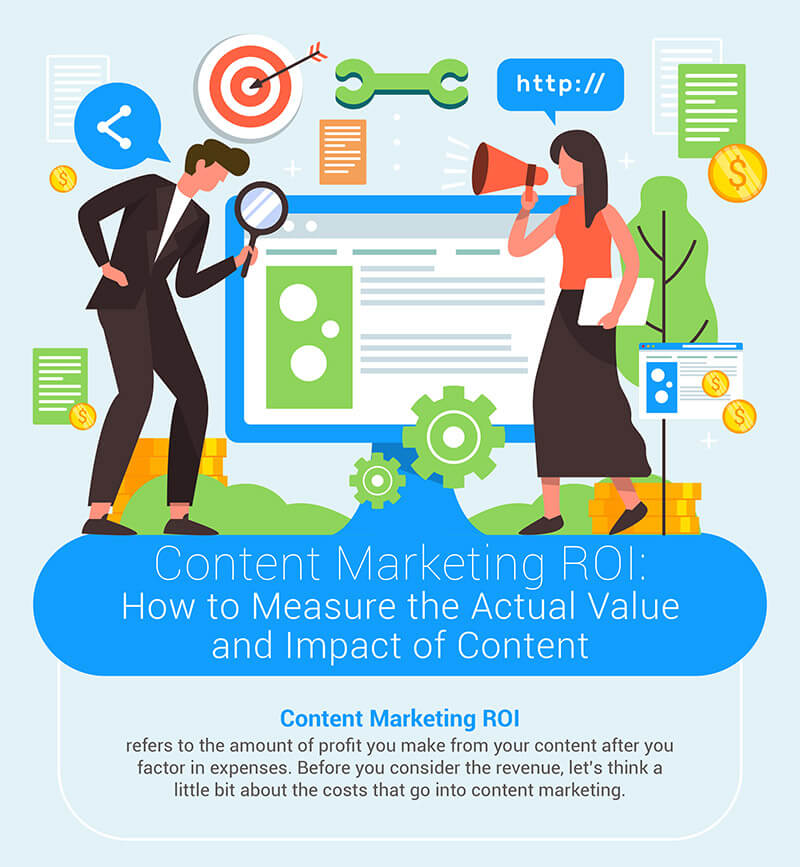
Content starts with the person you hire to create it. Make note of your content creator’s salary. If you’re working with a freelancer, tally up all of the expenses you’ve paid to them.
If your content creator works on other projects for your company and is paid hourly, estimate the percentage of their wage that goes to their time on content marketing.
Also factor in the work that every department puts into content marketing. While the contribution might be small, if a department puts enough time into marketing to have monetary value, factoring it into your content costs will give you a more accurate ROI.
Additionally, think of the cost of software used in content creation. You may also have subscriptions to image and video sites or pay for images as needed. These things should also go into your estimation.
Finally, include the costs you put toward pay-per-click marketing across platforms. If there are any additional methods you use to create and push content, include those as well.
A narrower view will see your content creator as “just writing blogs” or your marketing team as “just running advertisements.” It’s important to see these people and expenses as small pieces of your whole content marketing effort.
These numbers added together should equal your total expense.
Finding the ROI

As we mentioned earlier, the return of your content marketing comes in a variety of ways. Some of those returns have non-monetary value, and I’ll discuss them in a moment.
It’s easiest to assess your ROI in terms of cash value, however. In order to get a cold estimate of the money your content is bringing in, take a peek at the following equation.
ROI= (Return – Expense)/(Expense)
So, let’s say you’ve earned $40,000 from your content and you spent $10,000. Subtract your expense ($10,000) from your return ($40,000) and you get $30,000.
Divide that $30,000 by the expense ($10,000) and you get 3. In this case, your ROI is 300%.
Contributing Factors
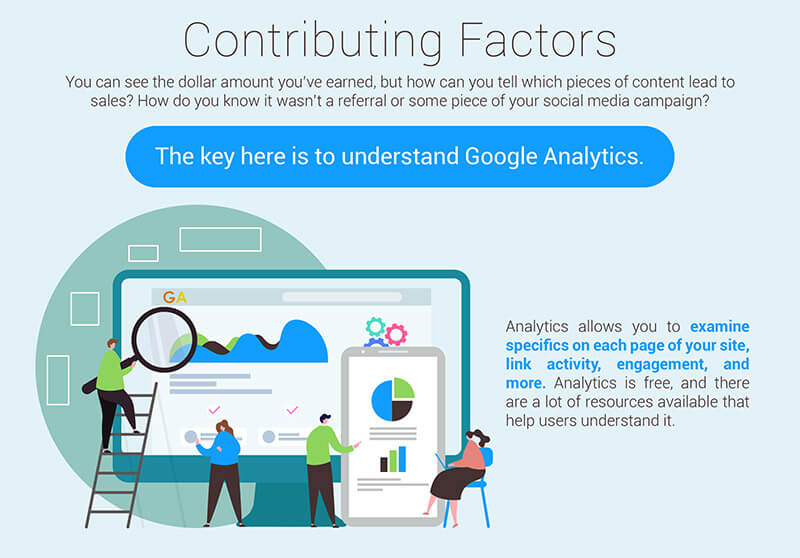
The return in terms of sales can be difficult to find off-hand. Sure, you can see the dollar amount you’ve earned, but how can you tell which pieces of content lead to sales? How do you know it wasn’t a referral or some piece of your social media campaign?
The key here is to understand Google Analytics. Analytics allows you to examine specifics on each page of your site, link activity, engagement, and more.
Using Google Analytics is absolutely essential in monitoring your content creation campaign. It would be almost impossible to know which pages are generating revenue and traffic without it.
I’ll touch on Google Analytics a little more in this article. I recommend reading up on the program a little bit in order to keep closer tabs on your page. Analytics is free, and there are a lot of resources available that help users understand it.
With that in mind, let’s move forward with some of the specific metrics that can help you assess content marketing ROI.
Lead Engagement
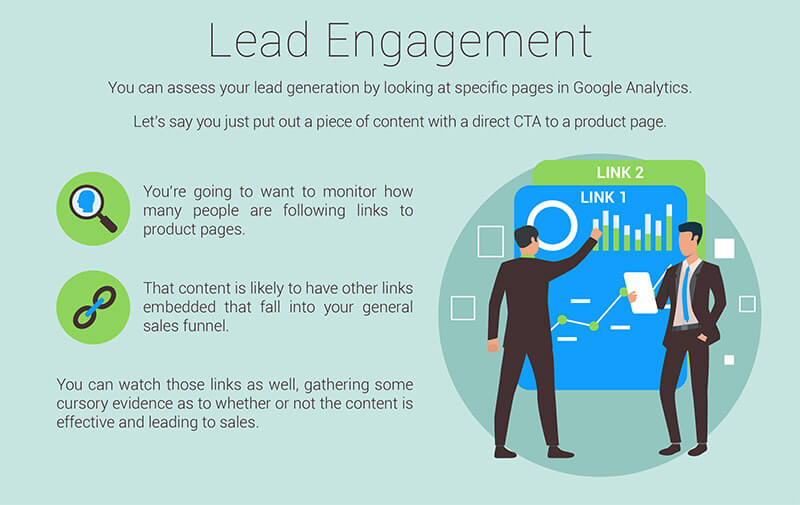
You can assess your lead generation by looking at specific pages in Google Analytics.
Let’s say you just put out a piece of content with a direct CTA to a product page. You’re going to want to monitor how many people are following links to product pages, and you can only do this by keeping up on Google Analytics.
That content is likely to have other links embedded that fall into your general sales funnel. You can watch those links as well, gathering some cursory evidence as to whether or not the content is effective and leading to sales, which we’ll cover next.
Whether or not traffic stays and engages with the various pages on your site as a result of a new piece of content is also relevant. Let’s say, for example, that a user sees the content, follows a link, and explores the sales page, but doesn’t purchase anything.
They may even browse around your site and view four or five pages, reading each one to completion. This is, by many accounts, a success. Even though the individual didn’t make a purchase, they’re aware of your site now.
It’s likely that they’ll come back when they need your product or service.
Sales Made

Sales are, of course, the most direct metric of your content’s success.
Watch the activity on sales pages when your content goes out. If there’s a correlation in the timing of activity, you can bet that it’s a result of the content.
Google Analytics has an excellent examination of specific pages and their corresponding sales. The program even breaks down your profit in terms of the average visitor and tracks where those visitors came to your site from.
In order to get specific sales information from Analytics, go to “Behavior,” then “Site Content,” then “All Pages.” You can look at the sales made, but, more importantly, you can see which pages lead the most users to your sales page.
In other words, you can monitor whether or not users are engaging with your new content and moving on to make purchases. In the swarm of other metrics to look at, this is going to be the most important.
Brand awareness and generation of web traffic is important, but what are those metrics if they don’t lead to sales? Examining the “All Pages” tab of Google Analytics will let you know whether or not your efforts are fruitful.
In order for Google to track this information, though, you must make sure that eCommerce in Analytics is enabled. Without enabling eCommerce, you won’t be able to see any of this extremely important information.
Changes in Traffic
Another way to gauge the value of content is whether or not it’s driving users to explore more of your site.
Large upticks in web traffic are often triggered by excellent content. As you start to grow, these spikes in traffic might be small. That said, any significant boost to your popularity is an excellent thing.
If you’re producing content that brings in traffic but doesn’t generate leads, don’t worry too much. You may just have to tweak your CTAs or format to focus on sales a little more.
In general, any content that attracts people will attract sales eventually. Users will become familiar with your site, and your product, and come back around when they inevitably remember you.
Content Engagement
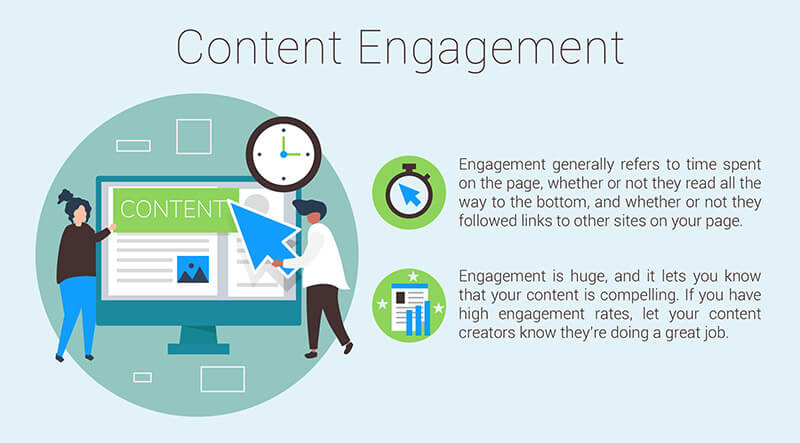
Another piece of the puzzle is the engagement that users have with your content. Engagement generally refers to time spent on the page, whether or not they read all the way to the bottom, and whether or not they followed links to other sites on your page.
Engagement is huge, and it lets you know that your content is compelling. If you have high engagement rates, let your content creators know they’re doing a great job.
Social Media Influence
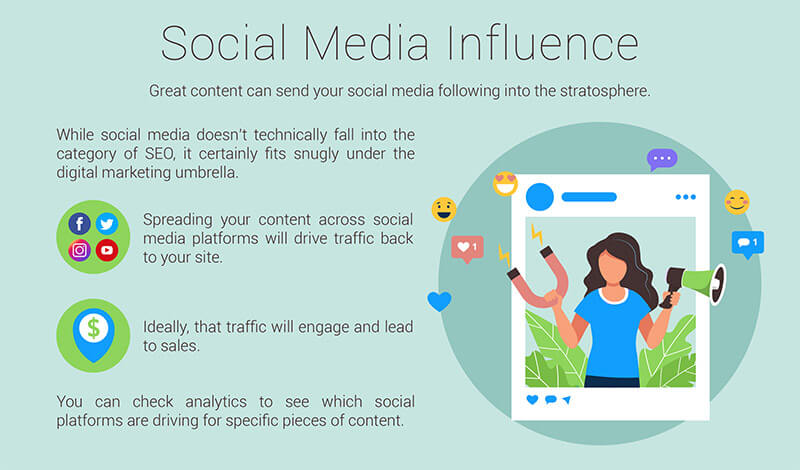
Great content can send your social media following into the stratosphere. While social media doesn’t technically fall into the category of SEO, it certainly fits snugly under the digital marketing umbrella.
Spreading your content across social media platforms will drive traffic back to your site. Ideally, that traffic will engage and lead to sales.
If you notice that you develop larger followings as a result of your content campaigns, your content is effective. You can check analytics to see which social platforms are driving for specific pieces of content.
Search Rankings

It’s important to think of your SEO as a factor in ROI. SEO is an essential piece of every digital marketing campaign and it requires a lot of work.
Your content creation should focus heavily on optimizing for specific keywords and phrases. This means researching the target audience, identifying their keyword trends, embedding keywords in the text, and optimizing pieces of the back end.
Effective content will rank highly in the search results. Search engines use over 200 factors to rank the relevancy of content against keywords, so it’s a difficult task. Backlinking, site architecture, brand popularity, and a whole lot more play into your spot in the Search Engine Results Pages (SERPs).
Over time, you should see a rise in rankings as a result of your content. You can monitor rankings by searching keywords from an incognito tab as well as through the use of Google Analytics.
SEO is its own animal, but it certainly plays into your content marketing ROI.
Effect on Brand’s Image
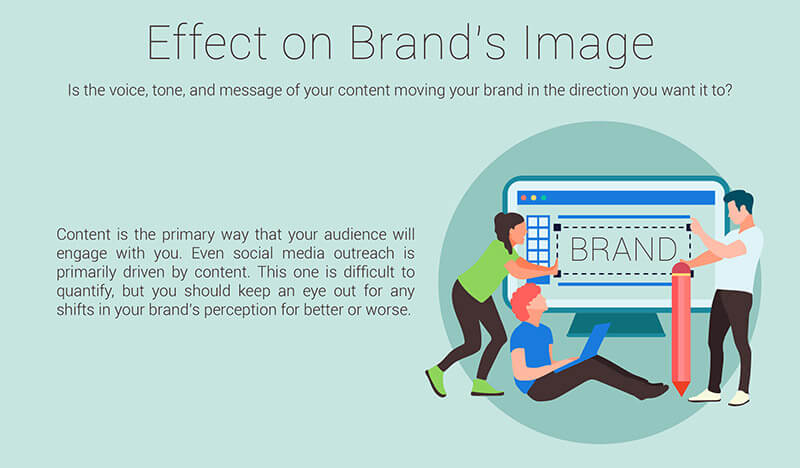
Finally, you should ask yourself if the content you’re putting out is adding value to your brand’s image. Is the voice, tone, and message of your content moving your brand in the direction you want it to?
Content is the primary way that your audience will engage with you. Even social media outreach is primarily driven by content.
So, you want to make sure that part of your return on content marketing is an improvement in your brand’s image and relationship to users. This one is difficult to quantify, but you should keep an eye out for any shifts in your brand’s perception for better or worse.
Piecing ROI Together
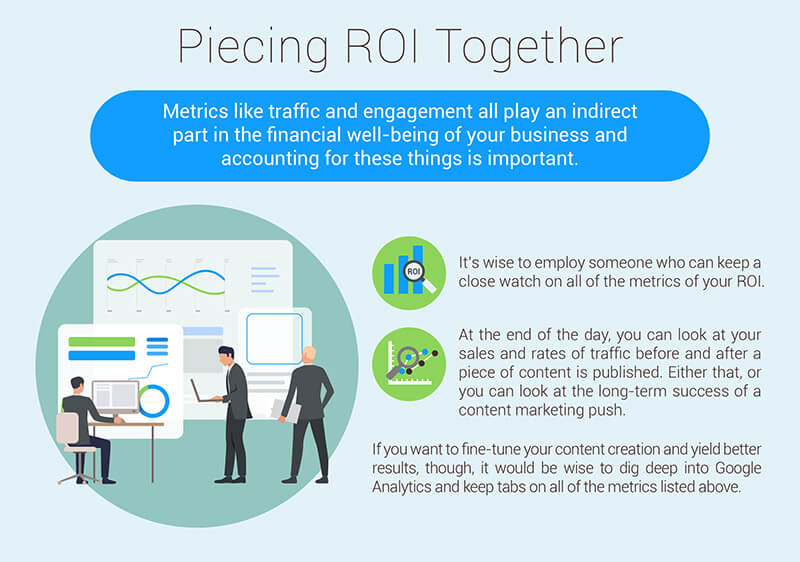
It should be clear now that financial gain isn’t the only component of your content marketing ROI. Metrics like traffic and engagement all play an indirect part in the financial well-being of your business and accounting for these things is important.
It’s difficult to keep a close watch on all of these metrics. It’s wise to employ someone who can keep a close watch on all of the metrics of your ROI. If that’s not in the budget for you, consider picking a few of the most significant aspects to your business.
At the end of the day, you can look at your sales and rates of traffic before and after a piece of content is published. Either that, or you can look at the long-term success of a content marketing push.
A light analysis like that will give you a rough sketch of your return on investment. If you want to fine-tune your content creation and yield better results, though, it would be wise to dig deep into Google Analytics and keep tabs on all of the metrics listed above.
Setting ROI Goals
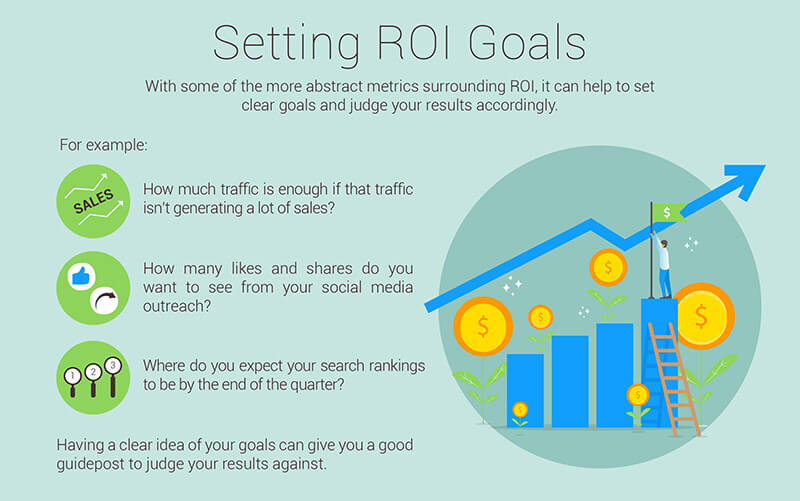
With some of the more abstract metrics surrounding ROI, it can help to set clear goals and judge your results accordingly.
For example, how much traffic is enough if that traffic isn’t generating a lot of sales? How many likes and shares do you want to see from your social media outreach? Where do you expect your search rankings to be by the end of the quarter?
Having a clear idea of your goals can give you a good guidepost to judge your results against.
Success in each metric will point back toward sales at the end of the day. That growth doesn’t always show up in your bank account right away, though, so it’s important to have ways to keep track of your success before that happens.
Need Help Moving Forward?
Digital marketing is a multifaceted effort, and content marketing ROI is just one complicated piece of the puzzle.
If you want to see big results, you’ll need to do a little research on the front end. Explore our site for more digital marketing information that’ll have you meeting your goals in no time.
Owner and Chief Marketing Officer, Jason Hall, and his team specialize in creating brand awareness / traffic and lead generation / marketing funnel and conversion optimization, while utilizing the appropriate marketing channels available within your industry. With diverse clients throughout the world, Jason's team is well connected within many industries to assist with your marketing strategies. With no long term contracts and various levels of service, Jason's team will increase the quality of your online traffic, leads, and sales.
Free Website Audit Tool
See how well optimized a web page, landing page, or blog post is for an exact keyword or phrase
About the author...
Located in the heart of the Emerald Coast - Destin, FL, founder and Chief Marketing Officer, Jason Hall, and his team specialize in creating brand awareness / traffic and lead generation / marketing funnel and conversion optimization / and PR campaigns, while utilizing the appropriate marketing channels available within your industry.
With diverse clients throughout the world, Jason's team is well connected within many industries to assist with your marketing strategies. With no long term contracts and various levels of service, Jason's team will increase the quality of your online traffic, leads, and sales.









